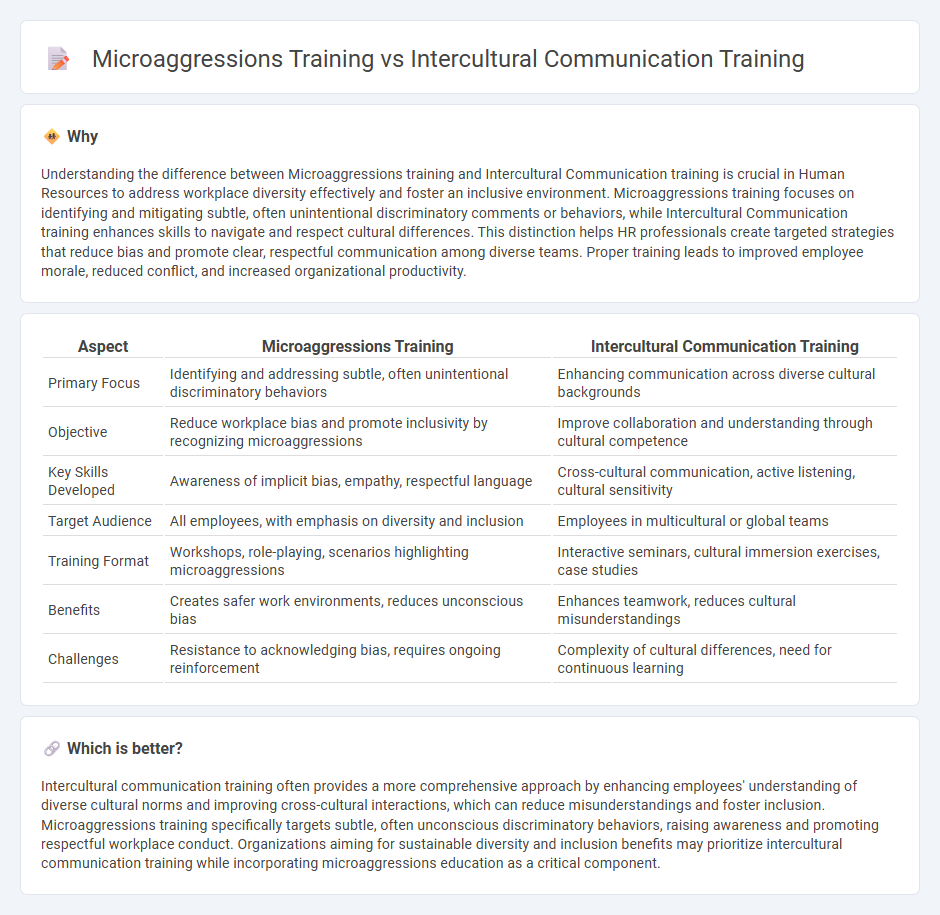
Microaggressions training focuses on identifying and addressing subtle, often unintentional discriminatory behaviors that impact workplace inclusivity and employee well-being. Intercultural communication training enhances employees' skills in effectively exchanging information and understanding across diverse cultural backgrounds, promoting collaboration and reducing misunderstandings. Explore how these trainings can transform your organizational culture and improve team dynamics.
Why it is important
Understanding the difference between Microaggressions training and Intercultural Communication training is crucial in Human Resources to address workplace diversity effectively and foster an inclusive environment. Microaggressions training focuses on identifying and mitigating subtle, often unintentional discriminatory comments or behaviors, while Intercultural Communication training enhances skills to navigate and respect cultural differences. This distinction helps HR professionals create targeted strategies that reduce bias and promote clear, respectful communication among diverse teams. Proper training leads to improved employee morale, reduced conflict, and increased organizational productivity.
Comparison Table
| Aspect | Microaggressions Training | Intercultural Communication Training |
|---|---|---|
| Primary Focus | Identifying and addressing subtle, often unintentional discriminatory behaviors | Enhancing communication across diverse cultural backgrounds |
| Objective | Reduce workplace bias and promote inclusivity by recognizing microaggressions | Improve collaboration and understanding through cultural competence |
| Key Skills Developed | Awareness of implicit bias, empathy, respectful language | Cross-cultural communication, active listening, cultural sensitivity |
| Target Audience | All employees, with emphasis on diversity and inclusion | Employees in multicultural or global teams |
| Training Format | Workshops, role-playing, scenarios highlighting microaggressions | Interactive seminars, cultural immersion exercises, case studies |
| Benefits | Creates safer work environments, reduces unconscious bias | Enhances teamwork, reduces cultural misunderstandings |
| Challenges | Resistance to acknowledging bias, requires ongoing reinforcement | Complexity of cultural differences, need for continuous learning |
Which is better?
Intercultural communication training often provides a more comprehensive approach by enhancing employees' understanding of diverse cultural norms and improving cross-cultural interactions, which can reduce misunderstandings and foster inclusion. Microaggressions training specifically targets subtle, often unconscious discriminatory behaviors, raising awareness and promoting respectful workplace conduct. Organizations aiming for sustainable diversity and inclusion benefits may prioritize intercultural communication training while incorporating microaggressions education as a critical component.
Connection
Microaggressions training and intercultural communication training are interconnected through their focus on fostering inclusive workplace environments by addressing subtle biases and enhancing cultural awareness. Both trainings equip employees with skills to recognize, understand, and respectfully navigate diverse cultural perspectives, reducing misunderstandings and promoting psychological safety. Organizations investing in these programs often see improved employee engagement, collaboration, and overall organizational effectiveness.
Key Terms
**Intercultural communication training:**
Intercultural communication training emphasizes understanding cultural differences, enhancing empathy, and building effective communication strategies across diverse cultural backgrounds to improve workplace collaboration and reduce misunderstandings. This training covers verbal and non-verbal communication styles, cultural norms, and values essential for global teams and international business success. Explore how intercultural communication training can transform your organization's dynamics and foster an inclusive environment.
Cultural Competency
Intercultural communication training emphasizes developing skills to interact effectively across diverse cultures, fostering cultural competency through awareness, knowledge, and adaptive communication strategies. Microaggressions training targets recognizing and mitigating subtle, often unintentional, discriminatory behaviors that impact marginalized groups, enhancing sensitivity and inclusivity within cultural interactions. Explore the distinctions and synergies between these trainings to deepen your understanding of cultural competency development.
Cross-Cultural Awareness
Intercultural communication training emphasizes developing skills to navigate diverse cultural contexts effectively, fostering understanding and reducing misunderstandings across global teams. Microaggressions training specifically targets recognizing and addressing subtle, often unconscious, discriminatory behaviors that impact workplace inclusion and psychological safety. Explore in-depth strategies to enhance cross-cultural awareness and promote respectful interactions within diverse environments.
Source and External Links
Intercultural Communication Training - Tennessee Language Center - Offers workshops and culture-specific training to help organizations navigate language and cultural differences, improve collaboration, and adapt communication styles for real-world professional settings.
Mastering Intercultural communication - Udemy - An online course teaching how cultural backgrounds shape communication, offering practical techniques to adapt styles, handle conflicts, and communicate effectively in multicultural environments through video lessons, role plays, and case studies.
Intercultural Communication - NCTI - A 10-week accelerated online course focusing on understanding cultural influences on communication, analyzing diverse perspectives and norms, and developing strategies to address cross-cultural communication gaps in various contexts.
 dowidth.com
dowidth.com